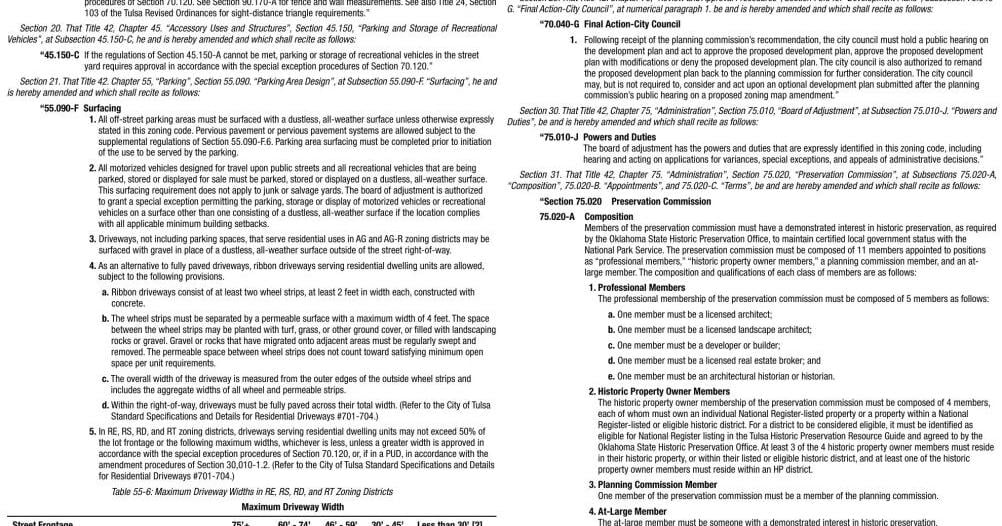
Pg. 2, continued from page 1 Bed & breakfast Rural retreat Short-term rental Marina S S S – P P S – S – Section 40.060 Section 40.375 INDUSTRIAL a. When a vehicular use area is located on a lot abutting an R- or AG-R-zoned lot, an R or AG-R district buffer must be provided in the form of an F1 screen, in accordance with §65.070-C.” Section 25. That Title 42. Chapter 65, “Landscaping and Screening”, Section 65.070, “Screening”, Subsection 65.070-B, “Features Required to be Screened”, at numerical paragraph 2. “Dumpsters” be and is hereby amended and which shall recite as follows: “2. Dumpsters All dumpsters must be screened from view of all street rights-of-way and R-zoned property, and AG-R zoned property. Screening of dumpsters located in alley rights-of-way is not required. Dumpsters may be screened from view by a principal structure or by an F1 screening fence or wall in accordance with §65.070-C. When an F1 screening fence or wall encloses a dumpster on four sides, one side of the storage area must be furnished with an opaque, lockable gate kept closed at all times except during waste deposit or collection. The gate must be located and constructed to allow for unobstructed access to each dumpster during collection.” Section 40.180 Mining or Mineral Processing Section 40.230 AGRICULTURAL Animal Husbandry [1] P – Community Garden P P Section 40.090 Farm, Market- or Community-supported [2] P S Section 40.090 Horticulture Nursery P – Section 40.225 S S Section 40.270” Section 26. That Title 42. Chapter 65, “Landscaping and Screening”, Section 65.070, “Screening”, Subsection 65.070-C, “Types of Screens”, by adopting new numerical paragraph 2. “S-2, Mid-profile Screen” be and is hereby amended and which shall recite as follows, with existing numerical paragraphs 2. 3. 4. and 5 being renumbered as follows: “2. S2, Mid-profile Screen a. Purpose The S2, mid-profile screen is intended to shield vehicles, headlights, and other elements of drive-throughs from view of abutting streets. OTHER Oil or Gas Well b. Design The S2 screen requires a low wall or berm, plus shrubs and trees between the wall/berm and the lot line. Section 15. That Title 42. Chapter 35, “Building Types and Use Categories”. Section 35.030, “Residential Use Category”, Subsection 35.030-B. “Group Living” at numerical paragraph 9. “Transitional Living Center”, he and is hereby amended and which shall recite as follows: (1) Enough shrubs must be planted to form a continuous hedge at least 3 feet in height. Shrubs must be at least 24 inches tall at the time of planting. Up to 40% of shrubs may be deciduous. “9. Transitional Living Center A community-based residential facility that provides room and board, a supervised living environment, counseling and rehabilitation services.” (2) One large tree, as defined in Section 65.080-B and listed in the Recommended and Prohibited Tree Species List, is required per 25 linear feet of landscaped area. If large trees are not feasible due to the presence of overhead lines or other utility obstructions, as determined by the land use administrator, at least one small tree is required per 15 linear feet of landscaped area. Section 16. That Title 42, Chapter 35, “Building Types and Use Categories”, Section 35.050, “Commercial Use Category”. Subsection 35.050-Q, “Vehicle Sales and Service” at numerical paragraph 4. “Personal Vehicle Repair and Maintenance”, he and is hereby amended and which shall recite as follows: (3) A screening wall or earthen berm with a minimum height of 3 feet and a maximum height of 4 feet is required along the full length of the interior side of the landscaped area. Walls used to satisfy S2 screening requirements must be constructed of brick, stone, cast stone, formed concrete or similar durable, low-maintenance materials. Plain concrete blocks are not allowed as a screening wall material unless capped and finished with stucco or another decorative material. “4. Personal Vehicle Repair and Maintenance Uses that repair, install or maintain the mechanical components of automobiles, small trucks or vans, motorcycles, motor homes, or recreational vehicles including recreational boats. Uses that wash, clean, or otherwise protect the exterior or interior surfaces of these vehicles are also included.” 3. F1, Screening Fence or Wall Section 17. That Title 42. Chapter 45, “Accessory Uses and Structures”, Section 45.030, “Accessory Buildings and Carports in R Districts”, at Subsection 45.030-A, “Accessory Building Size”, be and is hereby amended and which shall recite as follows:\ *** 4. Materials, Installation and Maintenance “45.030-A Accessory Building Size 1. RE and RS-1 Districts In RE and RS-1 districts, the total aggregate floor area of all detached accessory buildings not erected as an integral part of the principal residential building may not exceed 750 square feet or 40% of the floor area of the principal residential structure, whichever is greater. [1] [2] 2. RS-2, RS-3, RS-4, RS-5, RD, RT, and RM Districts In RS-2, RS-3, RS-4, RS-5, RD, RT, and RM districts, the total aggregate floor area of all detached accessory buildings not erected as an integral part of the principal residential building may not exceed 500 square feet or 40% of the floor area of the principal residential structure, whichever is greater. [1] [2] [1] For detached accessory buildings located within rear setbacks, see Section 90.090-C. 5. Modification of Requirements *** 6. Screening or Setbacks Triggered by Proximity to Nonresidential Areas/Features” Section 27. That Title 42. Chapter 70, “Review and Approval Procedures”, Section 70.030. “Zoning Map Amendments (Rezonings)”. Subsection 70.030-F, “Final Action-City Council”, be and is hereby amended and which shall recite as follows: “70.030-F Final Action-City Council 1. Following receipt of the planning commission’s recommendation, the city council must hold a public hearing on the application and act to approve the proposed zoning map amendment, approve the proposed amendment with modifications, including approval of a less intensive zoning district or an optional development plan, or deny the proposed amendment. The city council is also authorized to remand the proposed zoning map amendment back to the planning commission for further consideration.” [2] See Section 45.031-D.6 for exceptions to these floor area limits for accessory buildings containing an Accessory Dwelling Unit.” Section 18. That Title 42. Chapter 45, “Accessory Uses and Structures”, Section 45.031, “ADU, Accessory Dwelling Units”. Subsection 45.031-D, “Regulations”, at numerical paragraph 8. “Additional Regulations for Accessory Dwelling Units”, at subparagraph “a” be and is hereby amended and which shall recite as follows: “a. Entrances Building entrances to accessory dwelling units may not face the nearest side or rear property line unless there is an alley or street abutting that property line.” Section 28. That Title 42. Chapter 70, “Review and Approval Procedures”, Section 70.040, “Development Plans”, Subsection 70.040B, “Applicability”, at numerical paragraph 2. “Optional”, be and is hereby amended and which shall recite as follows: “2. Optional Property owners may elect to submit a development plan with any zoning map amendment application. The optional development plan process is also used to process proposals to provide access to lots via a private street. In acting on optional development plans, the planning commission is authorized to recommend and the city council is authorized to approve use and development limitations that are at least as restrictive or are more restrictive than the base zoning regulations. Optional development plans may not be used to obtain relief from otherwise applicable zoning code regulations. The city council is authorized to request an optional development plan from the applicant if they deem it appropriate at the time of their consideration of a proposed zoning map amendment.” Section 19. That Title 42, Chapter 45, “Accessory Uses and Structures”, Section 45.080. “Fences and Walls”, at Subsection 45.080-A, be and is hereby amended and which shall recite as follows: “45.080-A Fences and walls within required building setbacks may not exceed 8 feet in height, except that in required street setbacks fences and walls may not exceed 4 feet in height. However, in R zoned districts, fences up to 8 feet in height are permitted in side street setbacks of detached houses or duplexes located on corner lots and in street setbacks abutting the rear lot line of houses or duplexes located on double frontage lots. The board of adjustment is authorized to modify these fence and wall regulations in accordance with the special exception procedures of Section 70.120. See Section 90.170-A for fence and wall measurements. See also Title 24, Section 103 of the Tulsa Revised Ordinances for sight-distance triangle requirements.” Section 20. That Title 42, Chapter 45. “Accessory Uses and Structures”, Section 45.150, “Parking and Storage of Recreational Vehicles”, at Subsection 45.150-C, he and is hereby amended and which shall recite as follows: Section 29. That Title 42. Chapter 70, “Review and Approval Procedures”, Section 70.040. “Development Plans”, Subsection 70.040G. “Final Action-City Council”, at numerical paragraph 1. be and is hereby amended and which shall recite as follows: “70.040-G Final Action-City Council 1. Following receipt of the planning commission’s recommendation, the city council must hold a public hearing on the development plan and act to approve the proposed development plan, approve the proposed development plan with modifications or deny the proposed development plan. The city council is also authorized to remand the proposed development plan back to the planning commission for further consideration. The city council may, but is not required to, consider and act upon an optional development plan submitted after the planning commission’s public hearing on a proposed zoning map amendment.” “45.150-C If the regulations of Section 45.150-A cannot be met, parking or storage of recreational vehicles in the street yard requires approval in accordance with the special exception procedures of Section 70.120.” Section 21. That Title 42. Chapter 55, “Parking”, Section 55.090. “Parking Area Design”, at Subsection 55.090-F. “Surfacing”, he and is hereby amended and which shall recite as follows: “55.090-F Surfacing 1. All off-street parking areas must be surfaced with a dustless, all-weather surface unless otherwise expressly stated in this zoning code. Pervious pavement or pervious pavement systems are allowed subject to the supplemental regulations of Section 55.090-F.6. Parking area surfacing must be completed prior to initiation of the use to be served by the parking. 2. All motorized vehicles designed for travel upon public streets and all recreational vehicles that are being parked, stored or displayed for sale must be parked, stored or displayed on a dustless, all-weather surface. This surfacing requirement does not apply to junk or salvage yards. The board of adjustment is authorized to grant a special exception permitting the parking, storage or display of motorized vehicles or recreational vehicles on a surface other than one consisting of a dustless, all-weather surface if the location complies with all applicable minimum building setbacks. 3. Driveways, not including parking spaces, that serve residential uses in AG and AG-R zoning districts may be surfaced with gravel in place of a dustless, all-weather surface outside of the street right-of-way. 4. As an alternative to fully paved driveways, ribbon driveways serving residential dwelling units are allowed, subject to the following provisions. Section 30. That Title 42, Chapter 75, “Administration”, Section 75.010, “Board of Adjustment”, at Subsection 75.010-J. “Powers and Duties”, be and is hereby amended and which shall recite as follows: “75.010-J Powers and Duties The board of adjustment has the powers and duties that are expressly identified in this zoning code, including hearing and acting on applications for variances, special exceptions, and appeals of administrative decisions.” Section 31. That Title 42, Chapter 75. “Administration”, Section 75.020, “Preservation Commission”, at Subsections 75.020-A, “Composition”, 75.020-B. “Appointments”, and 75.020-C. “Terms”, be and are hereby amended and which shall recite as follows: “Section 75.020 Preservation Commission 75.020-A Composition Members of the preservation commission must have a demonstrated interest in historic preservation, as required by the Oklahoma State Historic Preservation Office, to maintain certified local government status with the National Park Service. The preservation commission must be composed of 11 members appointed to positions as “professional members,” “historic property owner members,” a planning commission member, and an atlarge member. The composition and qualifications of each class of members are as follows: 1. Professional Members The professional membership of the preservation commission must be composed of 5 members as follows: a. Ribbon driveways consist of at least two wheel strips, at least 2 feet in width each, constructed with concrete. a. One member must be a licensed architect; b. The wheel strips must be separated by a permeable surface with a maximum width of 4 feet. The space between the wheel strips may be planted with turf, grass, or other ground cover, or filled with landscaping rocks or gravel. Gravel or rocks that have migrated onto adjacent areas must be regularly swept and removed. The permeable space between wheel strips does not count toward satisfying minimum open space per unit requirements. b. One member must be a licensed landscape architect; c. One member must be a developer or builder; d. One member must be a licensed real estate broker; and e. One member must be an architectural historian or historian. c. The overall width of the driveway is measured from the outer edges of the outside wheel strips and includes the aggregate widths of all wheel and permeable strips. 2. Historic Property Owner Members The historic property owner membership of the preservation commission must be composed of 4 members, each of whom must own an individual National Register-listed property or a property within a National Register-listed or eligible historic district. For a district to be considered eligible, it must be identified as eligible for National Register listing in the Tulsa Historic Preservation Resource Guide and agreed to by the Oklahoma State Historic Preservation Office. At least 3 of the 4 historic property owner members must reside in their historic property, or within their listed or eligible historic district, and at least one of the historic property owner members must reside within an HP district. d. Within the right-of-way, driveways must be fully paved across their total width. (Refer to the City of Tulsa Standard Specifications and Details for Residential Driveways #701-704.) 5. In RE, RS, RD, and RT zoning districts, driveways serving residential dwelling units may not exceed 50% of the lot frontage or the following maximum widths, whichever is less, unless a greater width is approved in accordance with the special exception procedures of Section 70.120, or, if in a PUD, in accordance with the amendment procedures of Section 30,010-1.2. (Refer to the City of Tulsa Standard Specifications and Details for Residential Driveways #701-704.) 3. Planning Commission Member One member of the preservation commission must be a member of the planning commission. Table 55-6: Maximum Driveway Widths in RE, RS, RD, and RT Zoning Districts Maximum Driveway Width Street Frontage 75’+ 60’ – 74’ 46’ – 59’ 30’ – 45’ Less than 30’ [2] Driveway Within Right-of-Way (feet) [1] 27’ 26’ 22’ 20’ 12’ Driveway Within Street Setback (feet) [1] 30’ 30’ – – – [1] Maximum width is the sum of the width of all driveways. [2] Provided that for street frontages less than 24 feet, a driveway up to 12 feet in width is permitted. For approvals granted under the terms of the zoning code in effect prior to January 1, 2016, including (1) variances of maximum driveway coverage measured by width, square footage or percentage of yard and (2) establishment of PUD development standards that increase the maximum permitted driveway coverage measured by any such means, the foregoing maximums do not apply. 6. Pervious pavement or pervious pavement systems, including pervious asphalt, pervious concrete, modular pavers designed to funnel water between blocks, lattice or honeycomb shaped concrete grids with turf grass or gravel filled voids to funnel water, plastic geocells with turf grass or gravel, reinforced turf grass or gravel with overlaid or embedded meshes, resin-bound pervious pavement systems, or similar structured and durable systems are allowed as parking lot surfacing materials. Gravel, turf, or other materials that are not part of a structured system designed to manage stormwater are not considered pervious pavement or a pervious pavement system. Pervious pavement and pervious pavement systems must comply with the following: a. Materials must be installed and maintained in accordance with all applicable city standards. Damaged areas must be promptly repaired. Gravel that has migrated from a pervious pavement system onto adjacent areas must be regularly swept and removed. b. Accessible parking spaces and accessible routes from the accessible space to the principal structure or use served must comply with the building code. c. Pervious pavement or pervious pavement systems are prohibited in areas used for the dispensing of gasoline or other liquid engine fuels or where other hazardous materials are used or stored. d. Parking areas with pervious pavement or pervious pavement systems must have the parking spaces marked as required by this chapter, except that pervious pavement systems that utilize gravel or turf may use alternative marking to indicate the location of the parking space, including markings at the end of spaces on the drive aisle or curbing, wheel stops, or concrete or paver strips in lieu of painted lines.” Section 22. That Title 42. Chapter 55, “Parking”, Section 55.100, “Stacking Spaces for Drive-through Facilities”, at Subsection 55.100-C, “Location and Design”, be and is hereby amended and which shall recite as follows: *** 4. At-Large Member The at-large member must be someone with a demonstrated interest in historic preservation. 75.020-B Appointments Professional members, historic property owner members, and the at-large member of the preservation commission must be appointed by the mayor and confirmed by the city council. The planning commission member must be appointed by the planning commission to serve on the preservation commission. 75.020-C Terms The terms of office of all members of the preservation commission, except the planning commission member, will be 3 years. The planning commission member will serve terms on the preservation commission commensurate with the term of office served on the planning commission, without any of the limitations on terms provided in this paragraph. Regardless of the expiration of any term of office, except in the event of death, resignation, or removal from office, all members of the preservation commission must continue to serve until their successor is duly appointed by the mayor.” Section 32. That Title 42, Chapter 85. “Violations, Penalties and Enforcement”, Section 85.040, “Remedies and Enforcement Powers”, at Subsection 85.040-D. “Stop Work”, be and is hereby amended and which shall recite as follows: “85.040-D Stop Work A code enforcement official or the development administrator, with or without revoking permits, may stop work on any building or structure on any land on which there is an uncorrected violation of a provision of this zoning code or of a permit or other form of authorization issued under this or previous zoning codes. A stop work order shall be in writing and shall be posted at the property. A stop work order will be effective immediately upon posting at the property. Written notice, which states the reason for the stop work order and the conditions under which the cited work is authorized to resume, shall also be given to the owner of the property by mail based on property ownership information from the County Assessor’s office. No prior notice is required before a stop work order is issued. Any person who violates a posted stop work order may be subject to the criminal penalties described in Section 85.040-A.” Section 33. That Title 42, Chapter 90, “Measurements”, Section 90.090, “Setbacks”, at Subsection 90.090-C, “Permitted Setback Obstructions in R Zoning Districts”, at Table 90-1, “Permitted Setbacks in R Zoning Districts”, be and is hereby amended and which shall recite as follows: “Table 90-1: Permitted Setback Obstructions in R Zoning Districts Setback Obstruction Street Side Rear Accessory buildings (see also Section 90.090-C.2) No No [4] Yes [4] 1. Stacking lanes must be located on the subject property. They may not be located within required driveways or drive aisles, parking spaces or loading areas and may not interfere with access to parking and ingress and egress from the street. Air conditioning units No Yes Yes Arbors and trellises Yes Yes Yes 2. Except on corner lots, all areas associated with drive-through facilities, including drive-through signs, stacking lanes, trash receptacles, loudspeakers and service windows must be located to the rear or on the non-street-facing side of the property. Awnings, canopies, light shelves and architecturally integrated solar shading devices projecting no more than 2 feet into the setback Yes Yes Yes Barbeque pits and outdoor fireplaces No No Yes “55.100-C Location and Design 3. All areas associated with drive-through facilities must be screened from the street in accordance with the S2 screening standards of Section 65.070-C and the Street Frontage Buffer requirements of Section 65.060-C. The tree requirements of the S2 screen may be used to satisfy the street tree requirements of Section 65.040-B. 4. Drive-through lanes must be set back at least 10 feet from abutting R- or AG-R- zoned lots, and a screening wall or fence must be provided along the common lot line in accordance with the F1 screening fence or wall standards of Section 65.070-C.” Section 23. That Title 42, Chapter 60, “Signs”, Section 60.030, “Sign Exceptions”, at Subsection 60.030-B, “Drive-through Signs”, be and is hereby amended and which shall recite as follows: “60.030-B Drive-through Signs Bay windows projecting no more than 2 feet into the setback Yes Yes Yes Carports Yes [1] Yes [2] Yes [2] Chimneys and flues projecting no more than 2 feet into the setback Yes Yes Yes Clotheslines No Yes Yes Decks, patios, and other features and structures less than 30 inches in height above grade Yes Yes Yes Eaves and gutters projecting no more than 2 feet into the setback Yes Yes Yes Fences and walls (see also Section 45.080) Yes Yes Yes 1. Location Drive-through signs must be located within 10 feet of a drive-through lane. Fire escapes projecting no more than 4.5 feet into the setback Yes Yes Yes 2. Number and Dimensions One primary drive-through sign not to exceed 36 square feet in area or 8 feet in height is allowed per order station up to a maximum of 2 primary drive-through signs per lot. One secondary drive-through sign not to exceed 15 square feet in area or 6 feet in height is allowed per order station, up to a maximum of 2 secondary drive-through signs per lot.” Flagpoles and similar features Yes Yes Yes Geothermal heat pumps and geothermal heat exchange system equipment up to 4 feet in height above grade No No Yes Green houses and hoop houses (see also Section 90.090-C.2) No No [4] Yes [4] Insulation added to the outside of the exterior wall of an existing building Yes Yes Yes Plants and cold frames Yes Yes Yes Drive-through signs are permitted in conjunction with drive-through uses, in accordance with the following regulations. Section 24. That Title 42. Chapter 65, “Landscaping and Screening”, Section 65.060. “Vehicular Use Area Buffers”, Subsection 65.060-C. “Requirements”, at numerical paragraph 2. “R or AG-R District Buffers” be and is hereby amended and which shall recite as follows: “2. R or AG-R District Buffers



